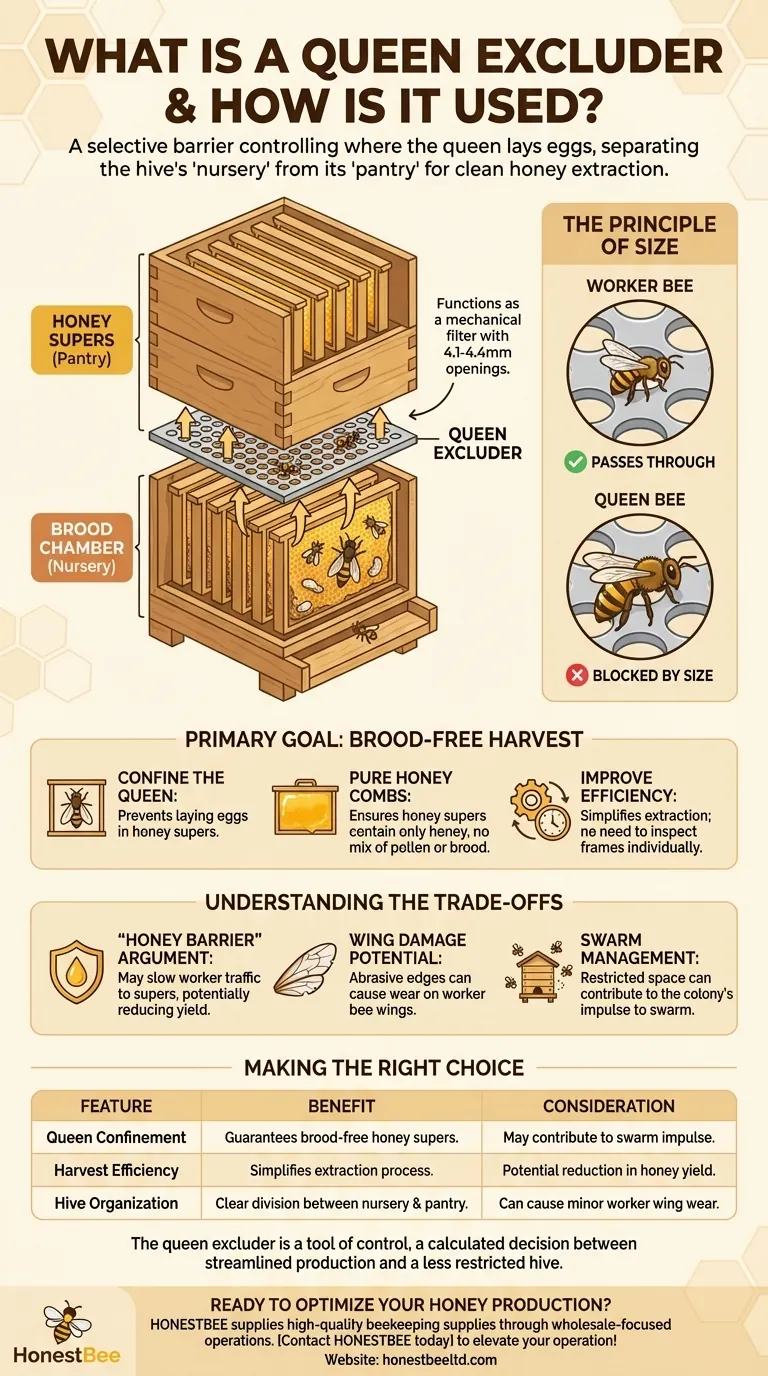A queen excluder is a selective barrier placed inside a beehive to control where the queen can lay eggs. It functions as a simple grate with openings, typically between 4.1 and 4.4 millimeters, that are large enough for worker bees to pass through but too small for the queen's larger thorax. This confines her to the lower sections of the hive, known as the brood chamber.
The core purpose of a queen excluder is to separate the hive's "nursery" from its "pantry." It ensures honey storage areas remain free of brood (eggs and larvae), which dramatically simplifies the process of clean and efficient honey extraction.

How an Excluder Works: The Principle of Size
A queen excluder's effectiveness relies entirely on the anatomical differences between the types of bees within a colony. It is a simple but highly effective mechanical filter.
Exploiting Bee Anatomy
The key difference is the size of the thorax. A queen bee's thorax is significantly larger than that of a worker bee. The precisely engineered gaps in the excluder are designed to permit the smaller workers to pass through unimpeded while physically blocking the queen.
Placement Within the Hive
The excluder is placed between the brood boxes (where the queen lays eggs and raises young) and the honey supers (the boxes stacked above that are intended for honey storage). This creates a distinct division of labor within the physical hive structure.
The Primary Goal: A Brood-Free Harvest
The most common reason beekeepers use an excluder is to streamline honey harvesting, a practice especially important in commercial operations.
Confining the Queen
By keeping the queen in the brood chamber, the beekeeper dictates exactly where egg-laying can occur. This prevents her from treating the entire hive as her nursery and laying eggs in the frames designated for honey.
Ensuring Pure Honey Combs
When a queen lays eggs in a honey super, the resulting comb will contain a mix of honey, pollen, eggs, and developing larvae. This makes honey extraction messy and risks contaminating the final product with brood.
Improving Efficiency
With an excluder in place, a beekeeper can be confident that every frame in the honey super contains only honey. This allows them to remove and process entire boxes at once without having to inspect each frame individually for brood, saving significant time and labor.
Understanding the Trade-offs
While effective, queen excluders are an optional tool, and their use is a subject of debate among beekeepers. Less than half of all beekeepers choose to use one.
The "Honey Barrier" Argument
Some beekeepers believe the excluder can act as a psychological or physical barrier that slows worker bees down. This hesitation to cross the barrier, they argue, can lead to reduced traffic into the honey supers and, consequently, a smaller honey harvest.
Potential for Wing Damage
The metal or plastic edges of the excluder can be abrasive. As worker bees repeatedly squeeze through the openings over their lifespan, they can suffer wear and tear on their wings, which may slightly reduce their foraging efficiency.
Swarm Management Considerations
If the bees feel the queen is "honey bound" or restricted, it can sometimes contribute to the colony's impulse to swarm. Beekeepers who don't use excluders must instead rely on careful hive inspection to manage space and prevent the queen from running out of laying room.
Making the Right Choice for Your Goal
Deciding whether to use a queen excluder depends entirely on your management style and beekeeping objectives.
- If your primary focus is harvesting efficiency: An excluder is an invaluable tool for guaranteeing brood-free honey supers and simplifying extraction.
- If your primary focus is a more "natural" or less intrusive approach: You may choose to omit the excluder, accepting the need for more diligent frame management to keep the queen in the desired area.
- If you are a new beekeeper: Using an excluder can be an excellent way to learn about hive organization and clearly delineate the functions of each part of the hive.
The queen excluder is a tool of control, and choosing to use one is a calculated decision between streamlined production and a less restricted hive environment.
Summary Table:
| Feature | Benefit | Consideration |
|---|---|---|
| Queen Confinement | Guarantees brood-free honey supers for a clean harvest. | May contribute to swarm impulse if the queen feels restricted. |
| Harvest Efficiency | Simplifies extraction; no need to inspect frames for brood. | Some beekeepers report a potential reduction in honey yield. |
| Hive Organization | Creates a clear division between the nursery and pantry. | Can cause minor wing wear on worker bees over time. |
Ready to optimize your honey production?
For commercial apiaries and beekeeping equipment distributors, a reliable queen excluder is key to maximizing harvest efficiency and product purity. HONESTBEE supplies high-quality, durable beekeeping supplies and equipment through wholesale-focused operations, helping your business thrive.
Contact HONESTBEE today to discuss your wholesale needs and elevate your beekeeping operation!
Visual Guide

Related Products
- Professional Plastic Queen Excluder for Modern Beekeeping
- Wooden Queen Bee Excluder for Beekeeping
- Premium Wood Framed Metal Wire Queen Bee Excluder
- Metal Queen Bee Excluder for Beekeeping
- High Performance Plastic Queen Excluder for Beekeeping and Apiary Management
People Also Ask
- What are the pros of using queen excluders? Boost Honey Production & Hive Efficiency
- How do queen excluders work in terms of spacing and bee movement? A Guide to Precision Hive Management
- What is a Queen Excluder and how does it work? Achieve Purer Honey & Better Hive Control
- What is the purpose of a queen excluder when adding a super? Streamline Your Honey Harvest
- How does a queen excluder work? Master Hive Management for Pure Honey Harvests



















